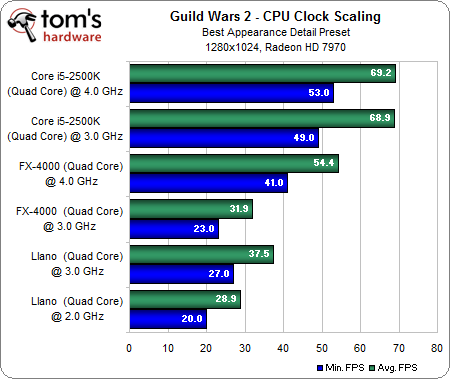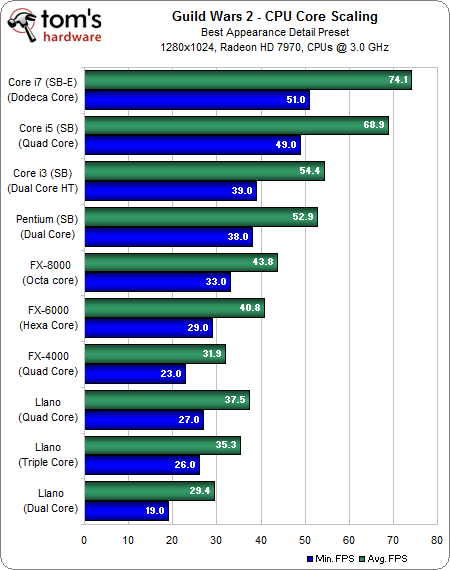Guild Wars 2: Your Graphics Card And CPU Performance Guide
The anticipated sequel to Guild Wars is here, and we're putting this MMO through its paces to let you know what hardware you'll need in order to play it at its highest details. We also explore which processor architectures work best with Guild Wars 2.
Do CPU Frequency And Core Count Matter?
We now know how a number of different graphics cards handle Guild Wars 2's various detail presets complemented by a fairly capable platform. But what happens when we pull the rug out from under the GPU with varied processor settings?
Using a trio of processor architectures (Intel's Sandy Bridge, AMD's Bulldozer, and a Llano-based APU) we isolated clock rate with quad-core configurations.
Sandy Bridge proves itself over and over in gaming workloads. Here, it's able to let our Radeon HD 7970 stretch its legs even at 3 GHz. Overclocking to 4 GHz yields very little extra performance.
AMD's dual-module FX-4000-series demonstrates a colossal gain between 3 and 4 GHz, though, telling us that the processor is bottlenecking performance in a big way at lower frequencies.
Pushing the Llano-based APU up to 3 GHz (from 2 GHz) is less rewarding, though there is a speed-up to be had. (Ed.: Clearly, it appears that AMD's best shot at catching Sandy Bridge at 3 GHz is a quad-core Bulldozer-based chip at 5 GHz or so. Sorry, couldn't resist).
The next experiment involves altering each architecture to determine how many processing cores Guild Wars 2 is able to exploit.
Four physical cores appear ideal, based on our results from the Sandy Bridge design. Sandy Bridge-E doesn't seem to introduce any benefit at all. Intel's dual-core, Hyper-Threaded Core i3 and dual-core Pentium are notably slower, though they still embarrass the eight-core AMD FX at 3 GHz.
Get Tom's Hardware's best news and in-depth reviews, straight to your inbox.
The six- and eight-core FX processors perform fairly similarly, while the quad-core FX-4000-series is quite a bit slower. Remember, though, that the eight-core chip actually consists of four Bulldozer modules. The six- and four-core parts feature three and two modules, respectively. Each module involves notable resource-sharing, which likely affects performance.
Three cores appear optimal on AMD's Llano-based APU. The fourth one yields very little performance gain. The dual-core Llano demonstrates the lowest results in this test.
Current page: Do CPU Frequency And Core Count Matter?
Prev Page Benchmark Results: Best Appearance Preset Next Page Guild Wars 2 Is Accessible, But Still Very ScalableDon Woligroski was a former senior hardware editor for Tom's Hardware. He has covered a wide range of PC hardware topics, including CPUs, GPUs, system building, and emerging technologies.
-
haplo602 get your graphs and test setup to match:Reply
Radeon HD 6450 512 MB GDDR5
Radeon HD 6670 512 MB DDR3
Radeon HD 7770 1 GB GDDR5
Radeon HD 6850 1 GB GDDR5
Radeon HD 7870 2 GB GDDR5
Radeon HD 7970 3 GB GDDR5
where's the 6850 in the graphs ? There's a 6870 instead ... -
rdc85 I'm wonder how my pII x4 955BE will perform, there none in the chart...Reply
Anyone know? at stock speed and at 3.8 O.C.... -
EzioAs Interesting. The less-than-$100-without-external-power-connector Radeon 7750 is a balance card providing appealing visual while still runs good framerates at 1080p. I imagined if you tinker with the Best Appearance preset a little bit you can get better image quality without framerates dropping below 30. I mean let's face it, who plays on their PC without tinkering the settings here and there, that's just stupid.Reply
Great review as always! Really appreciate it -
stingstang I'm disappointed that this neglects the post processing bar when determining if the best appearance setting is enabled when taking in to account processing ability. I have an fx4100 and an hd 7950. How will that do at high grahhics settings?Reply
Duh, we want to know this stuff. -
EzioAs Reply9536678 said:get your graphs and test setup to match:
Radeon HD 6450 512 MB GDDR5
Radeon HD 6670 512 MB DDR3
Radeon HD 7770 1 GB GDDR5
Radeon HD 6850 1 GB GDDR5
Radeon HD 7870 2 GB GDDR5
Radeon HD 7970 3 GB GDDR5
where's the 6850 in the graphs ? There's a 6870 instead ...
Although it's probably a typo, there's probably no need to use the 6850 as well since the 7770 should perform similar -
serhat359 stingstangI'm disappointed that this neglects the post processing bar when determining if the best appearance setting is enabled when taking in to account processing ability. I have an fx4100 and an hd 7950. How will that do at high grahhics settings?Duh, we want to know this stuff.It will be cpu limited, you'll get around 35-40fpsReply -
tomfreak Guild wars 2 min system requirements is Core 2 Duo 2.0 Geforce 7800, I would like u to test base on that too.Reply

